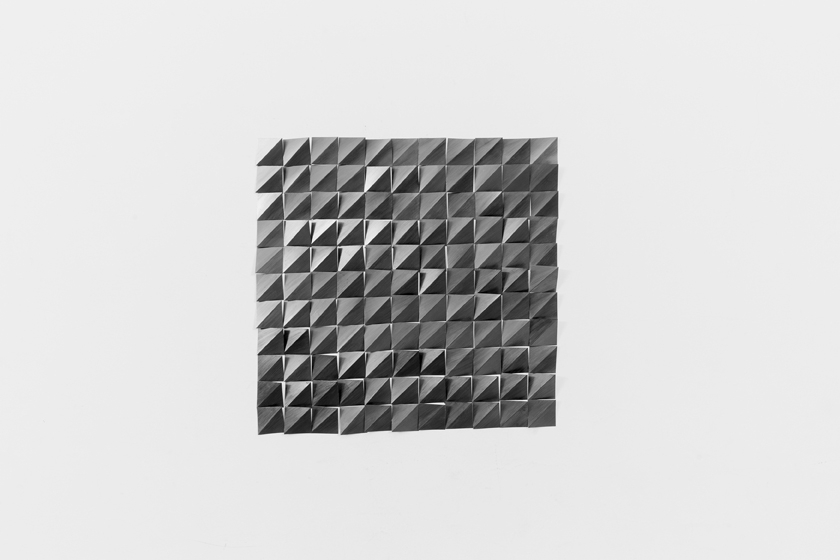From images it is truly difficult to determine what the work comprises, in physical terms. It’s probably paper, most likely folded to create what looks like a modest relief. Almost certainly with graphite applied on top. The surface is often symmetrically divided into dark squares and triangles. Yet it is slightly reflective and shimmers shyly. The work appears to be delicate and the size relates to the human scale. Later I learn that my speculations are more or less correct.
It should come as no surprise that Ayesha Sultana’s 2014 solo debut, at Kolkata’s Experimenter gallery, was titled Outside the Field of View. The artist is interested in that which escapes plain sight but which nevertheless has a palpable presence. Sometimes she is also interested in things that in the meantime have disappeared. Her drawings explore the rich variety of greys that graphite offers, as well as the transience of the medium that quickly takes on a life of its own unless carefully sealed. Hence, drawing is more of an activity, a verb, than a noun, or an end result; moreover, for Sultana it includes cutting, folding and layering as well. These intensive workings on the paper create frictions and ruptures that are set in contrast to the geometric order of the surface.
Sultana’s hometown, Dhaka, is a source of inspiration and even a direct reference in the work. It’s as if she wants to absorb and assimilate the impermanence and precarity of – to choose one example – the ever-present shantytowns. The use of metal plates of various kinds in those zones is reflected in the work – literally, via the inclusion of metal components. But more than that, such work, reliant on small pieces of fragile material, can be seen as a challenge to the dimensions of a city with over 15 million inhabitants, a buzzing street life and notorious traffic jams. Furthermore, there is a certain solemnity to Sultana’s intimate work, which – strangely – reminds me of architect Louis Kahn’s monumental and wondrous National Assembly Building of Bangladesh.
Another body of work is a series of appropriated colour photographs, which typically contain horizons and were mainly taken by her father on trips across the world. A mountain range, a desert, a riverbank, a forest, a cityscape seen from an airplane. Like the graphite drawings, none of them shows people. The images are placed outside and exposed to the weather: sunshine as well as rain. The results of this are stains and colour changes, but in addition the artist likes to scratch them, as if at once to highlight and damage them. Typically shown in clusters, the framed photographs are thus brought into the art context, once more demanding heightened perception from the viewers.
Sultana is a member of the Dhaka-based artist collective Britto Arts Trust, which recently curated a one-day exhibition in Old Dhaka, 1 Mile2 Dhaka, dealing with diversity in the neighbourhood. Forty artists participated and Sultana’s contribution was an installation on the walls of an old Hindu building. Meticulously filling existing cracks and fissures in the brick structure with gold-leaf sheets, she brought a sense of preciousness to the crumbling house.
Ayesha Sultana’s multifaceted practice hinges on transformation – paper rendered preciously glossy and geometric beneath sharp folds and layers of graphite, slack velvet banners, cosseting interventions in decrepit buildings – as well as painting and sound. The Dhaka-based artist, born in Jessore, Bangladesh, won the 2014 Samdani Art Award and has recently had solo exhibitions in Kolkata and Rome. Selected by Maria Lind, director of Tensta Konsthall, Stockholm, and an independent curator and writer.
Read all of our 2015 FutureGreats profiles
This article was first published in the March 2015 issue.
